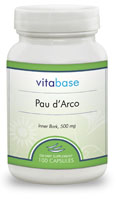| Pau d'Arco refers to both the name of the tree and the medicine made from its inner bark. The botanical names for the species most commonly used are Tabebuia heptaphylla and Tabebuia impetiginosa. Pau d'arco tree is a broad-leaf evergreen that grows to
a height of 125 feet and is distinguished by pink to violet colored flowers. It is indigenous to South America, especially in Peru and Argentina, where it grows high up in the Andes. It can also be found growing in low-lying ares in Paraguay and Brazil.
Pau d'arco contains quinones (lapachol), bioflavonoids, lapachenole, carnosol, indoles, coenzyme Q, alkaloids (tecomine), steroidal saponins , and minerals (especially calcium, cobalt, and silicon). Lapachol and beta-lapachone (known collectively as naphthaquinones) are two primary active compounds in pau d'arco. Naphthaquinones have anti-fungal properties as potent as ketoconazole, a common antifungal drug. They enhance the immune system, cleanse the body and stimulate the production of red blood cells, which can increase the amount of oxygen the blood can carry contributing to healing. Topically, pau d'arco appears to have varying amounts of antibacterial, antifungal, antiprotozoal, and antiviral properties.
Pau d'arco has pain killing, diuretic, anti-inflammatory, anti-infectious, anti-psoriatic, and anti-cancer abilities. Pau d'arco is commonly used in the herbal treatment of cancer, lupus, wounds, backache, toothache, sexually transmitted diseases, and infections (including ncluding candidiasis, herpes simplex virus, influenza, parasitic diseases such as schistosomiasis, bacterial infections such as brucellosis, cervicitis, and vaginitis). Pau d'arco may also reduce inflammation of the joints associated with arthritis. Pau d'Arco tea has been as a remedy for digestive disorders such as dysentery and colitis and for sore throats and fevers. |
 Pau d' Arco is an evergreen tree grown in the warmth of Central and South America particularly in the Amazon rain forest. The inner bark of the tree has been used for medicinal purposes by South Americans for centuries. During the 1960's, its potential benefits became more widely known and investigated in the medical community. Pau d'Arco by Vitabase is 100% pure inner bark and is carefully inspected to ensure the highest quality product. Click here for more information.
Pau d' Arco is an evergreen tree grown in the warmth of Central and South America particularly in the Amazon rain forest. The inner bark of the tree has been used for medicinal purposes by South Americans for centuries. During the 1960's, its potential benefits became more widely known and investigated in the medical community. Pau d'Arco by Vitabase is 100% pure inner bark and is carefully inspected to ensure the highest quality product. Click here for more information.